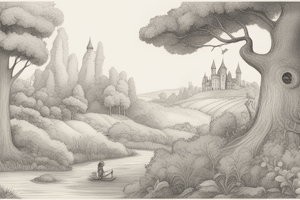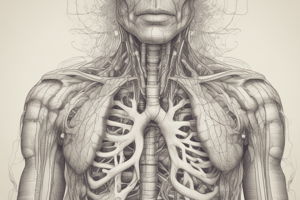Podcast
Questions and Answers
What is the primary function of the epiglottis during swallowing?
What is the primary function of the epiglottis during swallowing?
- To support the thyroid cartilage
- To close the glottis and push food into the esophagus (correct)
- To facilitate the flow of air to the lungs
- To assist in producing vocal sounds
What is the purpose of the c-shaped cartilage rings in the trachea?
What is the purpose of the c-shaped cartilage rings in the trachea?
- To enable the trachea to collapse during breathing
- To facilitate sound production
- To absorb excess air pressure
- To keep the trachea open for gas passage (correct)
Which cells are responsible for prevention of diffusion in the bronchial tree?
Which cells are responsible for prevention of diffusion in the bronchial tree?
- Simple squamous cells
- Transitional cells
- Cuboidal cells (correct)
- Ciliated columnar cells (correct)
What characterizes the structure of the bronchioles compared to the primary bronchi?
What characterizes the structure of the bronchioles compared to the primary bronchi?
Which statement is true regarding the larynx and its functions?
Which statement is true regarding the larynx and its functions?
What feature allows the alveoli to maximize gas exchange?
What feature allows the alveoli to maximize gas exchange?
How are the secondary bronchi differentiated from primary bronchi?
How are the secondary bronchi differentiated from primary bronchi?
Which layer of the respiratory system changes from columnar to squamous epithelium?
Which layer of the respiratory system changes from columnar to squamous epithelium?
What connective tissue structure lies between the thyroid and cricoid cartilages?
What connective tissue structure lies between the thyroid and cricoid cartilages?
What is the role of elastic tissues in the larynx?
What is the role of elastic tissues in the larynx?
Which structure is primarily responsible for gas exchange in the respiratory system?
Which structure is primarily responsible for gas exchange in the respiratory system?
What type of epithelium is primarily found lining the trachea?
What type of epithelium is primarily found lining the trachea?
Which of the following statements accurately describes the function of the diaphragm?
Which of the following statements accurately describes the function of the diaphragm?
What is the correct sequence of air passage through the bronchial tree?
What is the correct sequence of air passage through the bronchial tree?
Which structures are housed within each lobe of the lungs?
Which structures are housed within each lobe of the lungs?
What is the primary role of the hairs located in the external nares?
What is the primary role of the hairs located in the external nares?
Which feature distinguishes the histology of the bronchioles from that of the trachea?
Which feature distinguishes the histology of the bronchioles from that of the trachea?
Where is the larynx located in the respiratory system?
Where is the larynx located in the respiratory system?
Which of the following correctly identifies the lobes of the lungs?
Which of the following correctly identifies the lobes of the lungs?
What type of epithelium is found in the alveolar ducts and alveoli?
What type of epithelium is found in the alveolar ducts and alveoli?
What is the primary function of surfactant secreted by the lungs?
What is the primary function of surfactant secreted by the lungs?
How are the lobes of the right lung organized compared to the left lung?
How are the lobes of the right lung organized compared to the left lung?
Which of the following best describes the role of terminal bronchioles in the bronchial tree?
Which of the following best describes the role of terminal bronchioles in the bronchial tree?
What is the significance of the pleural cavity in lung function?
What is the significance of the pleural cavity in lung function?
Which statement accurately describes the bronchial tree's segmental bronchi?
Which statement accurately describes the bronchial tree's segmental bronchi?
Which condition is characterized by the permanent enlargement and destruction of alveoli, resulting in reduced elasticity?
Which condition is characterized by the permanent enlargement and destruction of alveoli, resulting in reduced elasticity?
What defines the structure and function of ciliated epithelium in the respiratory system?
What defines the structure and function of ciliated epithelium in the respiratory system?
Which term describes the condition where there is partial or complete collapse of a lung or a portion of it?
Which term describes the condition where there is partial or complete collapse of a lung or a portion of it?
Which characteristic distinguishes chronic bronchitis from other pulmonary diseases?
Which characteristic distinguishes chronic bronchitis from other pulmonary diseases?
What role does the diaphragm play in the process of breathing?
What role does the diaphragm play in the process of breathing?
Flashcards
Epiglottis
Epiglottis
A cartilage flap that prevents food from entering the trachea.
Glottis
Glottis
The opening in the larynx (voice box) that allows air to pass through during breathing.
Thyroid cartilage
Thyroid cartilage
The cartilage that surrounds the glottis, to which the thyroid gland is attached.
Cricoid cartilage
Cricoid cartilage
Signup and view all the flashcards
Cricothyroid membrane
Cricothyroid membrane
Signup and view all the flashcards
Trachea
Trachea
Signup and view all the flashcards
Bronchial tree
Bronchial tree
Signup and view all the flashcards
Alveoli
Alveoli
Signup and view all the flashcards
Primary bronchi
Primary bronchi
Signup and view all the flashcards
Bronchioles
Bronchioles
Signup and view all the flashcards
Right Lung Lobes
Right Lung Lobes
Signup and view all the flashcards
Left Lung Lobes
Left Lung Lobes
Signup and view all the flashcards
Bronchopulmonary Segments
Bronchopulmonary Segments
Signup and view all the flashcards
Lobules
Lobules
Signup and view all the flashcards
Alveoli
Alveoli
Signup and view all the flashcards
Pleural Cavity
Pleural Cavity
Signup and view all the flashcards
Surfactant
Surfactant
Signup and view all the flashcards
COPD
COPD
Signup and view all the flashcards
Emphysema
Emphysema
Signup and view all the flashcards
Lung Cancer Cause
Lung Cancer Cause
Signup and view all the flashcards
Respiratory System Function
Respiratory System Function
Signup and view all the flashcards
Respiratory Tract Pathway
Respiratory Tract Pathway
Signup and view all the flashcards
Bronchial Tree
Bronchial Tree
Signup and view all the flashcards
Alveoli
Alveoli
Signup and view all the flashcards
Ciliated Epithelium
Ciliated Epithelium
Signup and view all the flashcards
Nasal Cavity
Nasal Cavity
Signup and view all the flashcards
Lungs Structure
Lungs Structure
Signup and view all the flashcards
Diaphragm
Diaphragm
Signup and view all the flashcards
Gas exchange
Gas exchange
Signup and view all the flashcards
Larynx
Larynx
Signup and view all the flashcards
Study Notes
The Respiratory System
- The respiratory system allows gases from the environment to enter the bronchial tree through inspiration (expanding the thoracic volume).
- It permits gas exchange where oxygen diffuses into the blood and carbon dioxide diffuses into the bronchial tree.
- It permits gas elimination from the lungs through expiration (decreasing the thoracic volume).
General Anatomy
- The respiratory system is a tube that divides into smaller branching tubes within the lungs.
- The process begins with external nares (nostrils) leading to the nasal cavity, nasopharynx, laryngopharynx, larynx, trachea, primary bronchi, lungs (secondary bronchi), tertiary bronchi, bronchioles, alveolar sacs, and alveoli.
- The trachea has a carina (fork) that branches to the right and left primary bronchus.
- The right lung has three lobes (superior, middle, inferior) and the left has two (superior, inferior).
- The anatomy includes lobar and segmental bronchi, and interlobular bronchioles which branch into the smallest units in the lungs, the lobules.
- The bronchial tree is further subdivided into terminal bronchioles, respiratory bronchioles, alveolar ducts, alveolar sacs, and alveoli.
- Alveoli are microscopic air sacs where gas exchange occurs (similar surface area to a tennis court).
- Support structures like cartilage rings are present in larger tubes (bronchi) to allow gases to pass freely.
- Lungs are cone-shaped, located in the thoracic cavity. The space between the two lungs (pleural cavity) is filled with pleural fluid to prevent friction and collapsing.
Histology
- The tissue lining along the respiratory tract changes from the trachea to the tertiary bronchi (ciliated pseudostratified columnar epithelium, smooth muscle, and cartilage rings).
- Bronchioles are lined with cuboidal epithelium.
- Alveolar ducts and alveoli are lined with simple squamous epithelium.
Larynx (Voice Box)
- The larynx is surrounded by cartilages and serves as a passageway to move air in and out of the trachea.
- The epiglottis cartilage covers the glottis (opening of the larynx) when swallowing. This prevents food from entering the airway.
- The thyroid cartilage is connected to the cricoid cartilage.
- The larynx contains elastic tissue allowing sound generation when air flows through.
Nose and Nasal Cavity
- The nasal cavity (part of the nasal pharynx) contains hairs (external nares) that filter incoming air.
- The lining is pseudostratified columnar epithelium with cilia and mucus-producing goblet cells that trap and remove foreign substances.
- The nasal cavity also has warm air to prevent condensation.
Clinical Terms (Respiratory Diseases)
- COPD (chronic obstructive pulmonary disease)
- Emphysema
- Chronic Bronchitis
- Tuberculosis (TB)
- Atelectasis
- Lung Cancer (smoking is a major cause)
- Dyspnea (difficulty breathing)
- Pneumonia
Studying That Suits You
Use AI to generate personalized quizzes and flashcards to suit your learning preferences.




